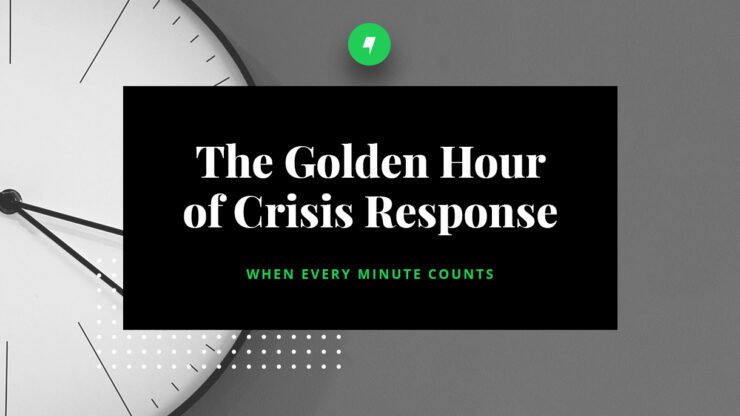Effective crisis response is a competitive advantage for any organization. Often, it is not the severity of the crisis that undoes an organization, but rather the timeliness and effectiveness of the response.
When a crisis occurs, speed matters and moving slowly to respond can be a bigger disaster than the event itself. This includes decision making during a crisis event, which should happen at a quicker pace than it typically would for other business decisions. Unfortunately, this fact is lost on many leaders in a crisis, and only in retrospect is there a realization that the response should have happened quicker.
The ideal timeframe in which to respond in a crisis is often referred to as The Golden Hour of Crisis Response (a term coined by Fred Garcia with the Logos Institute for Crisis Management), a metaphor taken from emergency medicine. For communicators, The Golden Hour isn’t necessarily a particular period of time, but rather refers to the time immediately following the event. Like emergency medicine, incremental delays in responding to a crisis have greater than incremental impact on the outcome.
As communicators in a crisis, our role is to quickly take control of the narrative and obtain what is sometimes referred to as the “first mover” advantage. That is, whoever is first to define the crisis is the one who controls the narrative. Here, speed deprives adversaries of the chance to form a harmful narrative against your organization or to disseminate inaccurate or incomplete facts. If you don’t make the first move, you will find yourself in a position where you’re responding to a narrative that another party has shaped, whether accurate or not.
What should happen during this Golden Hour?
The specifics will depend on the actual event, but generally here is what an organization should do:
- Gather the facts. Leadership and the crisis team should compile as much accurate information as possible, which will help inform the path forward.
- Determine the end goal. During this critical time, leadership and the crisis team should have a well-defined ideal end and keep it in mind when making decision on how to respond and to whom.
- Develop the message. Create a concise and honest account of what has happened. It’s very important that statements are as accurate as possible to be seen as credible. Even if all the information isn’t yet available, it’s okay to acknowledge that using the phrase “this is what we know right now.”
- Correct mistakes early. If inaccurate information is unintentionally shared, it should be corrected quickly and honestly. When contradictory facts are later revealed, or inaccurate comments are not corrected, creditably is lost and is extremely hard to regain.
- Communicate with empathy. In most cases, compassion should be the leading message. The public is less likely to forgive if an organization is perceived as not caring.
- Provide next steps or solutions. Once there is an acknowledgement of what happened, provide details about how the issue will be fixed or prevented from happening again in the future. Whether the situation is the fault of the organization or not, focusing on future action to address it will guide public perceptions in a positive direction and reduce the length of time the story is in the media.
- Continue to communicate updates. Once the initial onslaught of coverage of the crisis has died down, continue to inform key publics on the organization’s progress forward. This may be as simple as holding small internal meetings or as large as issuing media statements or holding press conferences.
Quick and effective crisis response within The Gold Hour allows an organization to move forward and get on with their business faster and more effectively. It also instills confidence in leadership both internally and externally.
If you’d like to learn more about who should be on an organization’s crisis team, click here.
Posted In Crisis Communications
 Jessica Sharp
Jessica Sharp 